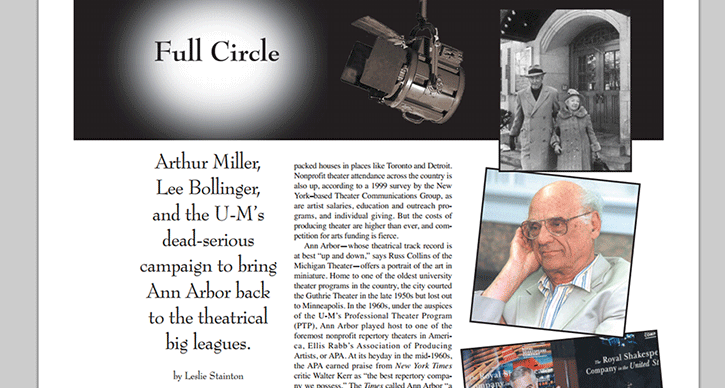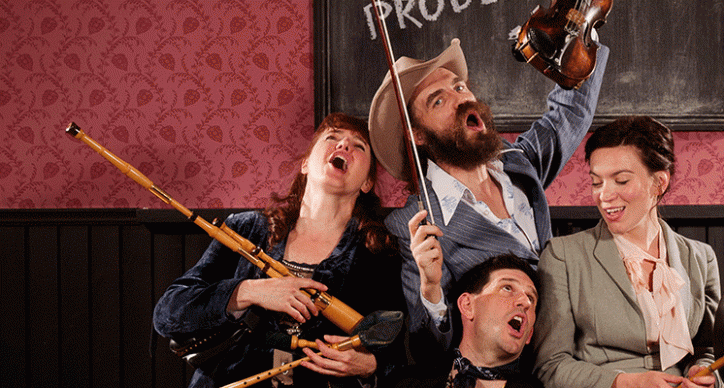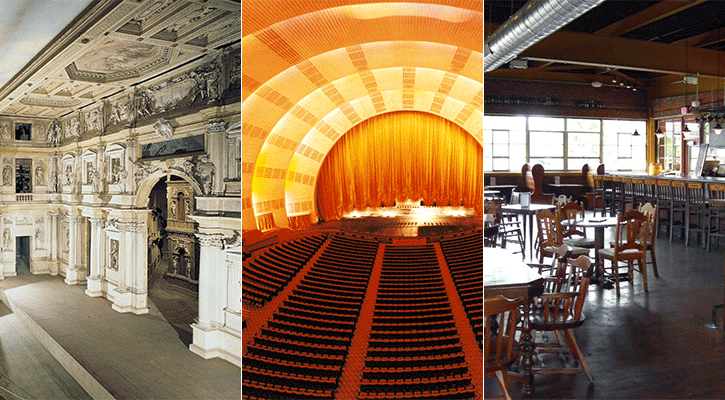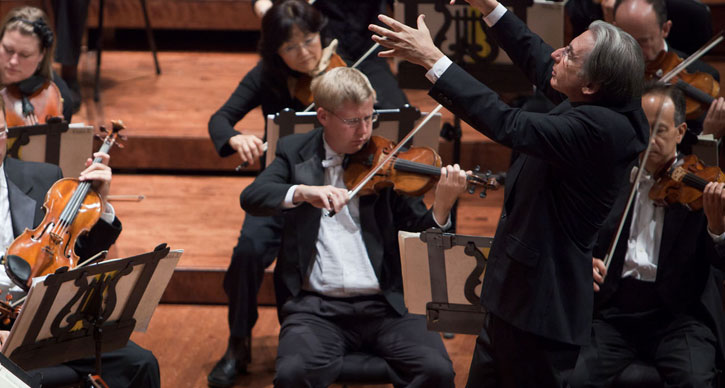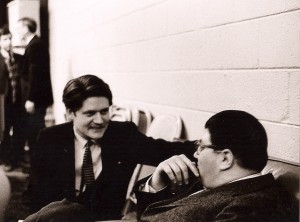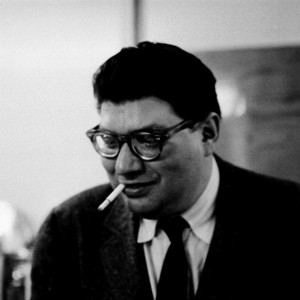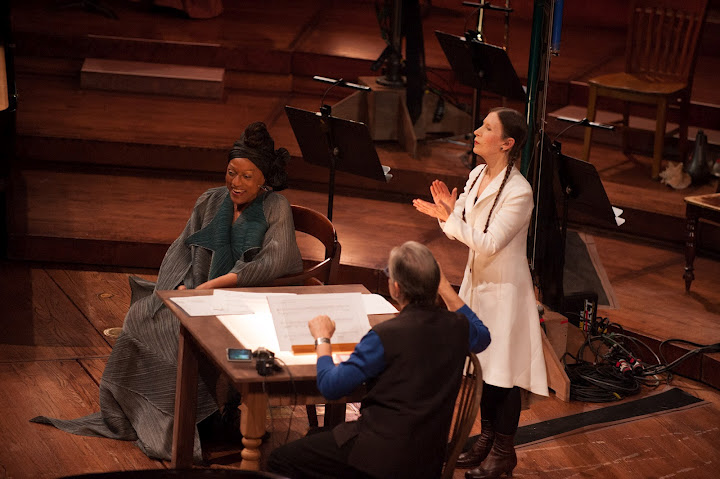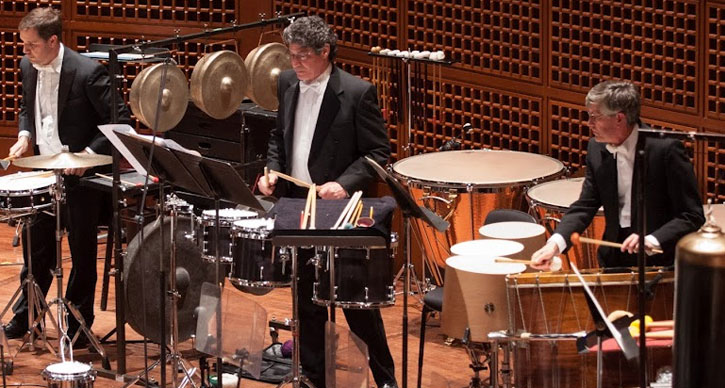Interview: Theater maker Young Jean Lee

Moments in Untitled Feminist show (left) and Straight White Men (right). Photos by Julieta Cervantes and Brian Mediana.
“Young Jean Lee is, hands down, the most adventurous downtown playwright of her generation.” (New York Times) This January, UMS showcases Young Jean Lee’s two most recent theater works on gender and identity. The plays are performed across the street from each other in the Power Center and Lydia Mendelssohn Theatre.
UMS Lobby regular contributor Leslie Stainton interviewed Young Jean Lee ahead of the visit.
Leslie Stainton: How do you define “theater”?
Young Jean Lee: I don’t have a definition for it. If someone calls it “theater,” then to me it’s theater.
To my knowledge, this will be the first time anyone’s deliberately paired Untitled Feminist Show with Straight White Men. What do you hope happens from that juxtaposition? What are you most curious about?
The shows are so different and appeal to such different audiences, but for me they’re both coming from a similar place. My hope is that seeing them back to back will encourage audiences to look for their similarities.
How do you go about choosing a language—verbal, nonverbal—for a specific work about a particular topic?
I’m always trying to find the best match between form and content. For the first workshop of Untitled Feminist Show in 2010 I wrote a script and after the showing, our audience did nothing but make academic arguments about feminism. I wanted to hit people on a more emotional, visceral level, so as we did more workshops, I kept cutting out more and more of the text until there was nothing left but movement, and the audience was forced to react emotionally. I tried hard to write words that could compete with the movement and dance, but I couldn’t. We found that movement communicated what we wanted much more strongly than words did
For Straight White Men, I saw the traditional three-act structure as the “straight white male” of theatrical forms, or the form that has historically been used to present straight white male narratives as universal. And I thought it would be interesting to explore the boundaries of that form at the same time as its content.
What role do you see for live performance in our technological age? In what ways, if any, must live performance evolve and/or adapt in a world of rapid technological change?
Theater has been around forever—it’s survived the advent of radio and television and film. It’s become part of our educational system. I don’t really see it going anywhere.
What issues are you yearning to tackle in your work (or not, given your penchant for writing about “the last thing” you’d want to write about!)?
The Native American genocide has been on my mind a lot lately.
What are you working on now?
I’m trying to figure out how to make my first feature film!
When did you first fall for live performance?
There was a summer stock theater in the town where I grew up, and my parents took me to see A Funny Thing Happened on the Way to the Forum when I was very young, and I was hooked.
Many of your pieces deal with identity. In what ways is theater especially well suited for addressing questions of identity?
I don’t know that it is. Identity is hard to address in any art form, I think.
What key trends do you see in American theater today?
I think that contemporary American theater is very aesthetically conservative, and that it charges way too much for tickets. It isn’t adventurous or challenging enough — I’m thinking of mainstream commercial theater where everything has a linear plot line and there’s very little formal experimentation. I think the New York experimental theater/performance scene is still exciting. The stronger artists tend to have longer developmental processes. The performers have a lot of charisma and intelligence. There’s a lot of collaboration. On the other hand, I think a danger with experimental theater is when it gets locked into its own kind of tradition and you just see a bunch of experimental-theater cliches being played out.
See Young Jean Lee’s Straight White Men and Untitled Feminist Show in Ann Arbor January 21-23, 2016.
Greek to Us: Q&A
With a work like Antigone—especially with a new translation, by the remarkable and always provocative Anne Carson—it’s tempting to focus on text. But as T.S. Eliot reminds us, ancient Greek drama is first and most importantly action:
Behind the dialogue of Greek drama we are always conscious of a concrete visual actuality, and behind that of a specific emotional actuality. Behind the drama of words is the drama of action, the timbre of voice and voice, the uplifted hand or tense muscle, and the particular emotion. The spoken play, the words which we read, are symbols, a shorthand, and often, as in the best of Shakespeare, a very abbreviated shorthand indeed, for the actual and felt play, which is always the real thing. The phrase, beautiful as it may be, stands for a greater beauty still. This is merely a particular case of the amazing unity of Greek, the unity of concrete and abstract in philosophy, the unity of thought and feeling, action and speculation in life.
—T.S. Eliot, “Seneca in Elizabethan Translation”
Why new translation?
New translations of canonical texts get commissioned all the time—often as a way to spotlight a hot new playwright. It’s frequently the case that the playwright doesn’t even speak the original language, so a theater company will commission a “transliteration” from a native speaker and/or scholar. The American playwright Constance Congdon, who has adapted both Molière and Gorki into English, describes “transliterations” as “more of a dramaturgical booklet”—a line by line rendering of a text, heavily footnoted with contextual info on words, meanings, cultural assumptions, how other translators have handled certain passages, and so on.
With Anne Carson, of course, there’s no such intermediate stage. A classicist and poet who’s long tangled with Greek and Latin, Carson brings all that contextual knowledge to bear on each line she translates. To get a good sense of the kinds of issues she must consider, look at her 2010 Nox, a book-length meditation on her brother’s death, in which Carson intersperses personal reflection with lexicographical entries detailing the multiple meanings of each word in a Catullus elegy.
About Nox, Carson has said, “Over the years of working at it, I came to think of translating as a room, not exactly an unknown room, where one gropes for the light switch. […] Prowling the meanings of a word, prowling the history of a person, no use expecting a flood of light.”
It may be helpful to think of a translation of a play as like a production of that play, in that both are provisional interpretations. The original text endures.
Antigone, Antigonick
This is the second time in recent years that Carson has visited Antigone, the third tragedy in Sophokles’ great Oedipus trilogy. In 2012 Carson published Antigonick, an enigmatic reimagining of the story that in parts hews to Sophokles’ original script but also roams further—to Brecht and Beckett and John Ashbery; to contemporary law; to Hegel’s take on “woman” and Lacan’s and George Eliot’s take on the character of Antigone; to the 1944 Paris premiere of Jean Anouilh’s Antigone, before an audience of French Resistance leaders. Antigonick features a mute character named Nick who is onstage throughout and who “measures things.”
Carson speaks of the difficulties of translation in a four-page epistle (“the task of the translator of antigone”) with which she opens Antigonick. Addressing Antigone directly, Carson writes:
my problem is to get you and your problem
across into English from ancient Greek
all that lies hidden in these people, your people
crimes and horror and years together, a family, what we call a family
Of the Antigone we’ll see in Ann Arbor, Carson has said, “Translation cannot convey the complex interactions of [the play’s] metaphorical system or the inevitability of the catastrophe to which it leads.” In particular, she notes that the play’s two main characters, Antigone and Kreon, “stand opposed to one another instinctually, in the very morphology of their language, in the very grain of the way they think and speak.” Watch for how this plays out onstage.
And listen for Carson’s startling rendering of certain phrases—
you greedy pissant little amateur terrorist
…
run your scam
take your profit
you will not lay that body in the grave
…
but human beings are susceptible
aren’t they, dear old Teiresias
to the profit-motive
—reminders of how contemporary this play’s meanings are.
Some Particularities of Greek Theater: Q&A
An interview with actress Juliette Binoche, who stars in Antigone by Sophokles
How does the production handle the chorus?
The ancient Greek chorus was an anonymous group of 15 men who typically stayed onstage throughout a performance, in the orchestra (or round stage). Their chief function was to sing and dance the choral odes that divide the acts of the tragedy. They also, occasionally, sang or chanted in lyric dialogue with the actors, and their leader—distinguished by costume—could also take part in the dialogue.
Ivo van Hove, who directed the production of Antigone we’ll see in Ann Arbor, cautions: “If you are not interested in the chorus as a director, better take your hands off a Greek tragedy. Better not do it.” Of the chorus in Antigone, he says it is “almost like the subconscious of the society.”
How does the production handle the gods?
No actual god appears in Sophocles’ Antigone, but the uncanny and the divine are formidable powers in the play, keenly felt and heeded. Carson describes the difficulty of capturing the essence of the Greek term eusebia—the “awe that radiates from gods to humans and is given back as worship”—in this tragedy. She settles on the English word “piety,” but concedes its utter inadequacy in this instance. You’ll hear it in the last words Antigone speaks before going to her death:
I was caught in an act of perfect piety.
The actor who speaks these words, Carson writes, “will evoke the permanent elsewhere of our longing for the love of gods by drawing it up from her own voice and being.” How will Binoche render it?
What about exits and entrances?
In his long and thoughtful examination of ancient Greek theater, Greek Tragedy in Action (1978), Oliver Taplin notes that entrances and exits are not just a matter of “stepping into or out of the action,” but key events that draw attention to the relationships on either side of them. An entrance is a first chance to gauge a character’s features, dress, attributes. By its manner and destination, an exit conjures the future. Pay attention to both.
What objects and tokens does the production employ?
Greek tragedy is sparing when it comes to stage props. When they’re used, it’s to define and substantiate characters’ roles, status, way of life.
What happens offstage? And on? And why?
What we typically think of as the “big” actions—battles, disasters, suicides—take place offstage in Greek drama. Of greater interest is how individuals react to those events.
The slow pace and sustained concentration of Greek tragedy can also seem alien. Antigone is no Shakespearean romp from heath to court to jail to bedroom. The number of actors is limited (generally no more than two to three principal actors onstage at a given time). Time and place are unified. The chorus is ever-present. But this is not a static, verbal, didactic work—it’s deeply theatrical and emotional.
Mirror scenes
Greek tragedians often set up pairs of scenes—almost always so as to underscore the differences between those scenes. The spareness of Greek drama makes these pairings all the more powerful. Often these twin scenes occur on either side of a central catastrophic reversal or peripeteia (Aristotle’s term). Watch for such scenes between Kreon and Antigone; Kreon and those who bring him information (the Guard, Teiresias); Kreon and the chorus.
Why do you think theater makers “return to the Greeks”? Will you see Antigone by Sophokles?
The State of Theater in Ann Arbor: Looking Back to 2000, and Looking Ahead
Editor’s note: This article initially appeared in the Ann Arbor Observer in October 2000 and offers a snapshot of the history of theater in Ann Arbor and major developments in the city’s theater life during this time.
Leslie Stainton is a regular contributor to UMS Lobby, focusing on theater. Her new book Staging Ground captures the history of one of America’s oldest and most ghosted theaters—the Fulton Theatre in Lancaster, Pennsylvania.
She participates in an authors panel on January 28, 2015, which also included U-M faculty Martin Walsh and Leigh Woods. While the panel will spotlight Staging Ground, it will also provide an updated look at the state of theater in Ann Arbor today.
We thought this “time capsule” would be a great read ahead of that panel.
Arthur Miller, Lee Bollinger, and the U-M’s dead-serious campaign to bring Ann Arbor back to the theatrical big leagues.
It’s been nearly sixty-five years since Arthur Miller sat in a rented room at 411 North State Street in Ann Arbor and in six days wrote his first play. That work, No Villain, won Miller a Hopwood Award worth $250—half the sum it had cost him to come to Michigan in the first place—and convinced him he had what it took to compete with the reigning Broadway playwrights of his day: people like Clifford Odets, Maxwell Anderson, and Philip Barry.
Today, of course, Miller’s name outshines all the rest. “He’s the greatest living American playwright,” says U-M English prof Enoch Brater. With Eugene O’Neill and Tennessee Williams, Miller created the plays that became the bedrock of American theater. His best-known work, Death of a Salesman, has been performed around the world. Last year’s Broadway revival won four Tony Awards half a century after the play premiered in 1949.
Arthur Miller returns to Ann Arbor this month to give the keynote address at an international symposium honoring him on his eighty-fifth birthday. It’s an auspicious moment in the American theater, nationally as well as locally.
An Up and Down Track Record in Ann Arbor
From New York to California, the commercial stage is thriving. For the first time in years, thanks to a booming economy, every theater on both Broadway and Off Broadway is lit. Big musicals earn huge grosses in New York and spawn profitable touring productions that play to packed houses in places like Toronto and Detroit. Nonprofit theater attendance across the country is also up, according to a 1999 survey by the New York–based Theater Communications Group, as are artist salaries, education and outreach programs, and individual giving. But the costs of producing theater are higher than ever, and competition for arts funding is fierce.
Ann Arbor—whose theatrical track record is at best “up and down,” says Russ Collins of the Michigan Theater—offers a portrait of the art in miniature. Home to one of the oldest university theater programs in the country, the city courted the Guthrie Theater in the late 1950s but lost out to Minneapolis. In the 1960s, under the auspices of the U-M’s Professional Theater Program (PTP), Ann Arbor played host to one of the foremost nonprofit repertory theaters in America, Ellis Rabb’s Association of Producing Artists, or APA. At its heyday in the mid-1960s, the APA earned praise from New York Times critic Walter Kerr as “the best repertory company we possess.” The Times called Ann Arbor “a major regional theater center.”
Since then, it’s been a roller-coaster ride. By 1970 the APA had largely dissolved. The PTP continued to bring in touring shows from the likes of Ontario’s Stratford Festival and John Houseman’s Acting Company, but its visionary co-directors, husband and wife Robert Schnitzer and Marcella Cisney, retired shortly after the construction of the Power Center for the Performing Arts in 1971. In 1973 the PTP was merged into the U-M theater department and placed under the direction of the department chair, a move that further weakened the once maverick organization. “It never got back on its feet again, which is heartbreaking,” says longtime producer, performer, and Ann Arbor theater patron Judy Dow Rumelhart.
Rumelhart herself was involved in a brief attempt to create an outdoor Greek theater festival in Ypsilanti in the late 1960s. The theater’s first and only season starred Ruby Dee, Dame Judith Anderson, and Bert Lahr. But fragile community support, poor leadership, and a deteriorating economic climate doomed the effort.
In the late 1970s Ann Arbor theater aficionado Jim Packard spearheaded an ambitious town-gown endeavor to organize a summer performing arts festival on the scale of Stratford. “I believe it is the manifest destiny of Ann Arbor to become the cultural capital of the region,” Packard said at the time.
But despite an elaborate, two-year planning process that included detailed marketing and feasibility studies, consultations with nonprofit theater professionals throughout the country, and grants from the National Endowment for the Arts and the National Endowment for the Humanities, among others, the project foundered—partly because of turf wars between the city and the university, partly because of a statewide recession, and partly because the university was not prepared to market the endeavor on the scale it required. From the spoils of the project, today’s much smaller Ann Arbor Summer Festival emerged.
Twice in the 1980s the U-M tried to establish professional companies in alliance with its theater department, but both efforts—Walter Eysselinck’s Michigan Ensemble Theater and John Russell Brown’s Project Theater—folded after a few seasons. In each case, the department chair was simultaneously artistic director of the professional company, in an arrangement that had already proved unworkable in the early 1970s.
In 1991 Hollywood actor Jeff Daniels opened the Purple Rose Theater in his hometown, Chelsea. In 1996 Ann Arbor’s Performance Network went professional. Both companies are opening new theaters this season, a mark of their prosperity (see sidebar, “Reversals of Fortune”).
But Purple Rose and Performance Network are small companies that present exclusively new plays on modest budgets. Ann Arbor continues to lack the kind of first-rate anchor that a large-budget, nationally visible theater such as the Guthrie in Minneapolis provides.
In a now legendary irony, Sir Tyrone Guthrie toyed with putting his theater in Ann Arbor in the late 1950s but ultimately chose Minneapolis because of its more lucrative business climate. U-M administrators gave Guthrie an initially “cool reception,” remembers Wilfred Kaplan, who was involved in the effort to lure Guthrie to Ann Arbor. That, coupled with a lukewarm response from the Detroit business community, steered Guthrie away from Michigan. “Everyone had to come together, and they didn’t,” Kaplan recalls.
Theater: The Weak Sister
Today, Ann Arbor’s theater scene doesn’t begin to approach its musical and dance offerings in either quality or quantity. In a town that routinely sees the likes of the Berlin Philharmonic, Yo Yo Ma, Mark Morris, and the Martha Graham Company, theater is “the weak sister,” says Russ Collins. Collins attributes the situation to Ann Arbor’s German-immigrant heritage. “Music is strong because the Germans valued it. These social patterns hold sway even when the ethnic relevance has gone away.”
For U-M president Lee Bollinger, theater is the missing link in Ann Arbor’s otherwise rich cultural picture. “We should have theater that is as vibrant as the music that we experience on campus,” he says. A passionate advocate of the arts who carries a copy of Shakespeare with him much of the time and tries to read something from it “almost every day,” Bollinger has put theater at the center of his vision for the university. In fact, the former law professor and dean is the one person with both the imagination and the means to change not only the university’s but Ann Arbor’s theatrical fortunes in a big way, and he seems determined to do it.
At a press conference last spring, Bollinger announced plans to build a Walgreen Drama Center near the Power Center, on the university’s Central Campus. The new complex will include two theaters: a 600-seat Arthur Miller Theater and an as yet unnamed 100-seat space.
During the same press conference, University Musical Society president Ken Fischer announced the launch of the first full-fledged theater season in the organization’s 122-year history. The season, which opens this month, will include appearances by the Gate Theater of Dublin, Harvard University’s American Repertory Theater, and a three-week residency by one of the world’s foremost classical theater companies, the Royal Shakespeare Company. The season ends next April with a performance piece that UMS has co-commissioned with composer Benjamin Bagby and theater director and visual artist Ping Chong.
A Look at the RSC Residency
By far the largest, most expensive, and riskiest component of the UMS theater season is the RSC residency. “It’s the biggest thing we have ever done. Ever,” says Fischer. RSC is presenting all eight Shakespeare history plays in chronological order in a single year, an “extraordinary dramatic marathon,” in the words of the New York Times, that’s rarely been tried on any stage. The company will present four of those productions at the Power Center next March. In addition to paying the staggering cost of transporting a company of fifty-three (thirty actors and a crew of twenty-three) to Ann Arbor for three weeks, UMS is contributing significantly to the cost of producing the series, which will open in its entirety in Stratford, England, move to London, and conclude in abbreviated form in Ann Arbor. No other foreign tour is planned.
The transatlantic partnership that has evolved between the two groups is unique, according to Barbara Grove, RSC’s American representative: “It goes much beyond a tour. This has turned into a prototype.” Under the terms of its agreement, RSC will visit Ann Arbor at least two more times in the next five years and will make UMS its premier university partner in the United States.
The company itself “honestly contends they could not have done this cycle as they’re doing it without the University of Michigan,” Grove says. As a measure of its respect, RSC recently invited Bollinger to serve on its American board of directors.
Bollinger realizes that many in the community find his interest in theater surprising. “One of the great things about being university president,” he admits, “is that people have such low expectations of your cultural interests.”
If UMS is unable to raise its $2.5 million share of support for the RSC project, Bollinger has guaranteed that the university will make up the shortfall. In addition, he has already assembled most of the $20 million it will take to build the Walgreen Drama Center. Michigan alumnus Charles Walgreen Jr. has contributed between $11 and $12 million to the project, and Bollinger will use an undesignated bequest to the university to cover most of the rest.
Arthur Miller Theater
He is especially eager to build the Arthur Miller Theater. While some believe the university is moving too fast on the project—“I believe they should have [first] built an entire theater department, an Arthur Miller School of Theater,” says Rumelhart—Bollinger contends that it’s time the university honored its link to one of the most enduring voices in American, and indeed world, culture. “This is what you hold up to the students—that one of the greatest playwrights of the twentieth century found his talents here,” the president says.
When he first pitched the idea of an Arthur Miller Theater to Miller himself, the playwright sent back a note that now sits, framed, in Bollinger’s office. “The theater is a lovely idea. I’ve resisted similar proposals from others but it seems right from Ann Arbor,” Miller wrote.
The question now is whether Bollinger’s commitment portends a new golden age for theater in Ann Arbor—or whether this is just another bump in the roller coaster.
In Arthur Miller’s heyday, the great playwrights of the age were all seen on Broadway. Production costs and ticket prices for New York and major touring shows weren’t as prohibitive as they are now, and the theater was part and parcel of middle-class life and culture. Certain plays—Death of a Salesman among them—became part of the nation’s collective consciousness.
That happens far less frequently today—“which doesn’t mean the theater is in a bad state,” suggests Enoch Brater, who is organizing this month’s Arthur Miller symposium and will be a key participant in the Musical Society’s theater outreach programs. It does mean, though, that the old rules don’t apply. Theater—especially theater in a digitized, cable-ready twenty-first century—must reinvent itself, as it has countless times in its history, if it is to be anything but a quaintly anachronistic pastime.
Why do people go to the theater, anyhow?
Why do people go to the theater, anyhow? Simply to be entertained? To be sociable? To learn something? Or does live theatrical performance continue to meet some fundamental human need that no other medium can approach?
Obviously, those who have devoted themselves to the art think it does. Broughton believes “the more time we spend in front of these TV monitors, the more we want live entertainment. Theater lets you interact.”
“The more inundated people are with technology that’s been manipulated and studied to appeal to a preconceived notion of what audiences want, the more valuable live performance is,” maintains UMS’s [Director of Programming] Michael Kondziolka. “We program against that culture. And guess what? People are hungry for it. People are coming in record numbers to our programs, which are decidedly non–market driven—if by ‘market driven’ you mean tested and focus-grouped and surveyed and preresearched.”
At Chelsea’s Purple Rose, selling live theater to young audiences, in particular, is “a survival issue,” says artistic director Guy Sanville. “Tomorrow’s audiences are found in today’s classrooms.” What’s more, Sanville contends, theater is “a healing alternative to a chemical high. Arts and music are the drugs of choice for millions of kids.”
At its most basic level, a volunteer theater like the Ann Arbor Civic serves much the same social function as a church—it’s a gathering place for the community. Although he does not want the university’s multimillion-dollar Arthur Miller Theater to serve exclusively as a community theater, Lee Bollinger has said he is “open” to both community and student use of the space. He does not intend to place it under the control of either the theater department or the School of Music, however. Bollinger’s vision is larger than that. He’s convened a universitywide committee to consider plans for the new complex, as well as a trio of informal advisors: Broadway producer Robert Whitehead, Purple Rose founder Jeff Daniels, and Jack O’Brien, a Michigan alumnus who is artistic director of the Old Globe Theater in San Diego.
Bollinger concedes that he’s not yet sure what will go into either the Miller Theater or the Walgreen Drama Center once they’re built. He wants the complex to be a place for the creation of new work. He’ll seek an endowment to fund national and international collaborations with professional companies and a playwright-in-residence program. He’s toying with the idea of finding an artistic director to oversee “major alliances, new-play programs,” and the like. He is “open to thinking about UMS running it.”
He acknowledges that what’s missing from the Ann Arbor theater scene is professional theater of the very highest caliber. But he is admittedly vague about how he would address that deficiency, or whether he even wants to. He’s not sure whether the new Miller Theater should be strictly a presenting house for shows developed elsewhere or should occasionally produce its own plays.
Bollinger hopes to choose an architect by the end of this month. Construction of the new complex is expected to take several years. In the meantime, performing-arts organizations as disparate as UMS, Performance Network, the Ann Arbor Civic Theater, and University Productions, which manages most of the other stage spaces on the U-M campus, are watching developments closely.
A continuing commitment
One thing is clear: although Lee Bollinger’s determination is sufficient to build an Arthur Miller Theater, a continuing commitment will be needed if it is truly to live up to its name.
“Ann Arbor could have as rich a theatrical life as it does music if the University of Michigan, or some other group of subsidizers, will invest for ten years,” Russ Collins believes. “Theater has been strongly supported here in the past, but then debt and ambivalence set in, and it goes away. There needs to be a commitment of a significant period of time.”
Mark Lamos, former artistic director of the Hartford Stage Company in Connecticut and an adjunct professor in the U-M theater department, goes farther: “For a community such as Ann Arbor to support professional theater at the highest level, you need a group of people who believe in it so strongly they will be willing to fund-raise ceaselessly, choose and support artistic and management leaders, and be standard-bearers within the community for the institution. Every great regional theater began as a dream of pillars of the community.”
Such a theater, Lamos continues, also requires “large corporate pockets, large personal ones,” and an audience “that will sustain and support a variety of theatrical productions. An audience for an institution must be developed not through a hit-and-flop mentality but through a newly discovered conviction that the institution itself is more important than any one show—that its artistic mission is worth subscribing to.”
Finding and maintaining such support isn’t easy. Lamos left Hartford Stage in 1997, after seventeen seasons at its helm, because he’d grown tired of the ceaseless struggle for money. “Corporations were merging or downsizing, and the same group of wealthy arts devotees were being pursued by hospitals, universities, the symphony, the ballet, the museum. The community became too small to support my visions of artistic growth and institutional expansion.” Ann Arbor, he points out, is even smaller than Hartford.
It’s unclear, too, how a town the size of Ann Arbor, a four-hour drive from Chicago, the nearest major theatrical center, can attract the country’s finest actors, directors, and designers. Unlike musicians, who can fly in and out of a city in a matter of days or even hours to give a concert, theater artists typically need weeks of ensemble rehearsal to mount a production. Why spend that time in Ann Arbor?
Why spend time in Ann Arbor?
“We have to think about what could happen in Ann Arbor, in regard to theater, that could not happen in New York, Chicago, or London,” says Enoch Brater. “What can we allow theater professionals who are based there to do here that they can’t do there?”
Brater believes the university is the answer. In the absence of significant federal support, he maintains, universities today “are the great patrons of the arts. We can’t rely on Congress anymore. And it’s unrealistic to rely only on private support.”
It’s a vision Lee Bollinger shares—and he’s even writing a book on the subject. Last year Bollinger quietly provided $10,000 in university funds so that, under the auspices of UMS, singer Jessye Norman and choreographer Bill T. Jones could spend a week on campus working, in private, on a project they ultimately premiered in New York as part of the Lincoln Center Great Performances series. According to Ken Fischer, both artists reported afterward that they accomplished more “in one week in Ann Arbor than they could have in three months in New York.”
As Bollinger, Fischer, and their collaborators launch their new theater initiative, they can draw both inspiration and caution from the U-M’s own history. Back in the 1960s, generous university support enabled Ellis Rabb and his APA to develop productions in Ann Arbor that the company then took to New York. At the same time the Professional Theater Program, which brought the APA and other companies to campus in the 1960s, operated with little university control, as UMS does now.
Back in 1961, when university administrators invited Robert Schnitzer and Marcella Cisney to move to Ann Arbor from New York to run the PTP, they offered to build the couple a new theater. The pair turned it down. Writing about that gesture in a 1970 article for Players: The Magazine of the American Theater, journalist Glenn Loney observed, “The American Way is to build a theater in haste and then try to find out how to use it somehow, at leisure. [Schnitzer and Cisney] understood what few other artistic teams have: that you must first find out who your audience is, where it is, what it wants, what it needs—not always the same thing—and what varieties of creativity and service you can hope to present.”
Paradoxically, after Schnitzer and Cisney finally agreed to a new theater, and not long after the university built the Power Center, the couple left town. “It was retirement time, darling,” recalls Schnitzer, who, at age ninety-four, now lives in Connecticut. “I felt I’d paid my dues. It was a strenuous business, that dozen years. We worked like dogs.”
Schnitzer and Cisney were certainly entitled to their retirement, but without their leadership the PTP drifted and soon faded away. What’s to prevent history from repeating itself with the Arthur Miller Theater?
An Audience Ten Years Later
By September UMS had already sold over 1,000 complete RSC cycle tickets, and Fischer and Kondziolka are optimistic that the momentum can be sustained in subsequent seasons. “We think the time is right,” Kondziolka says. “We can help support the university by starting the labor-intensive, difficult work of building an audience, reestablishing a community, so that by the time the Arthur Miller Theater opens its doors there will be an audience ready, willing, and excited to accept this gift.”
That would be a tremendous accomplishment, and an essential prelude to the creation of a successful new theater. But will the Arthur Miller Theater continue to thrive ten or fifteen years down the road, once the novelty of the idea has worn off? Will a 600-seat theater be sufficient to offset the costs of producing or presenting world-class work, especially in a post-Bollinger administration whose focus is likely to be elsewhere? Will community leaders be willing, as Mark Lamos alleges they must, to “do anything on earth—including mortgage their homes” to keep the theater alive? Or was Tyrone Guthrie right when he decided that Ann Arbor couldn’t support the level of theater he had in mind?
At the outset, of course, the ball is in Bollinger’s court. It bodes well that the president himself is passionately excited by the prospect of bringing topflight theater to Ann Arbor. Shortly after Bollinger announced his plans for the building, Russ Collins sent him a note saying he hoped that Bollinger would listen “to his own inspiration and vision on this. It’s going to take that kind of leadership.”
There’s one other piece of advice that Bollinger would be especially wise to heed. It comes from Miller himself, who after all has chosen Ann Arbor as the one city to have a theater bearing his name. When the playwright learned last May that the regents had approved the Arthur Miller Theater, he wrote to Bollinger, “Who would have believed back in 1932–1934 when I was saving $500 to go to Michigan that it would come to this? Now to mount some memorable productions!”
Don’t miss the authors panel on January 28, 2015 at the Ann Arbor District Library, which includes Leslie Stainton as well as U-M faculty Martin Walsh and Leigh Woods. Moderated by UMS Director of Education & Community Engagement Jim Leiha. The panel will spotlight Staging Ground and also provide an updated look at the state of theater in Ann Arbor today.
Who Are We?
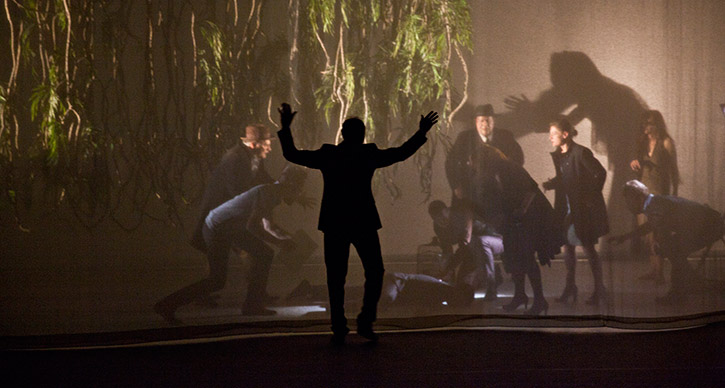
Théâtre de la Ville performs Luigi Pirandello’s Six Characters in Search of an Author at the Power Center in Ann Arbor on Oct 24-25, 2014. Photo by JL Fernandez.
While I was working on a biography of poet, playwright, and theatre director Federico García Lorca many years ago, I was startled to discover that Lorca had planned to meet up with the dramatist Luigi Pirandello in Italy in 1935. The two intended to collaborate—but Lorca cancelled the trip after Mussolini invaded Abyssinia (it was one of the rare overtly political gestures of Lorca’s life), and the two men never met.
I’ve often wondered what would have happened if they had. For both playwrights shared, among other things, a fascination with the nature of theater. Lorca probed the topic throughout his life, in plays that contain plays and rehearsals within plays, plays whose cast lists include directors and actors and playwrights (including Lorca himself). He introduced all manner of theatrical claptrap into these works—puppets, masks, screens (behind which identities abruptly change), miniature stages, outlandish costumes and props.
Pirandello was similarly obsessed. You see it big time in Six Characters in Search of an Author, a play that, if done well, should produce something like imaginative whiplash in the audience. (I’ve only seen the work produced once, in a student production at NYU, with way too much scenery-chewing. But having seen Théâtre de la Ville’s exquisitely nuanced production of Ionesco’s Rhinoceros two years ago in Ann Arbor, my hopes are high.)
What’s real? Who’s acting?
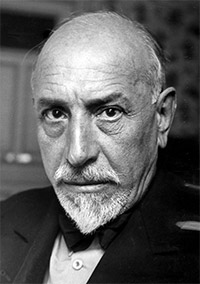
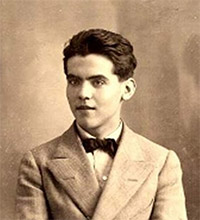
On left, Luigi Pirandello, and on right, Federico García Lorca.
What’s real? Who’s acting? Are the events and emotions we see onstage reality? Is what we experience and witness in “real life” acting? Can you trust what you see on a stage? In a conversation with your spouse or best friend or boss?
Aren’t these the questions that lie beneath the pleasures we associate with theater? (With film too, but I don’t think the experience is ever quite as acute on a screen.)
The setup for Pirandello’s exploration of theatrical artifice is straightforward: six purportedly fictional characters barge into a mostly empty theater to impose their story on a director and group of actors who are trying to rehearse a play. Actors become audience. Characters become actors. The layers multiply and confusions mount.
In line after line, we’re asked to consider the contradictions at the heart of play-making.
DIRECTOR: Then the theater is full of madmen, is that what you’re saying?
FATHER: Making what isn’t true seem true … for fun … Isn’t that your purpose, bringing imaginary characters to life?
Elsewhere the Father—one of Pirandello’s “six characters”—cries out that his story isn’t literature, it’s “life! Passion!” To which the Director responds: “That may be, but it won’t play.”
“What’s a stage?” a character asks toward the end of the play, and answers her own question. “It’s a place where people pretend to be very serious.”
The Empty Space
Exchanges like this abound—and make you question the theatrical enterprise and its conventions. Do we really need all the devices we’ve come to associate with the theater? The curtain and spotlights and scripts and applause? Peter Brook famously said (in his indispensable 1968 book The Empty Space) that in order for an act of theater to take place, all you need is for one person to walk across an empty space while another watches.
Brook published his book some 40 years after Pirandello wrote Six Characters, which opens on a stage whose atmosphere, Pirandello instructs, “is that of an empty theater in which no play is being performed.”
The Italian Pirandello grew up steeped in the venerable stuff of theater—the comic and tragic masks of the ancient Greek and Roman stage, the stock characters of thecommedia dell’arte. He understood (as did Lorca and that greatest of playwrights, Shakespeare) that identity is at the core of acting. As one of Pirandello’s six “characters” points out, “We all try to appear at our best, but we all know the unconfessable things that lie within the secrecy of our own hearts. We are not what we seem—even to ourselves.”
Don’t you change your personality according to the situation and your audience?
In another book I find indispensable, The Actor’s Freedom: Toward a Theory of Drama (1975), critic Michael Goldman probes precisely these questions. Identification is the “covert theme of drama,” Goldman writes. This isn’t simply a matter of actors identifying with roles but of “the making or doing of identity.” You watch an actor, onstage or on screen, and wonder where her private life stops and the public, performed one begins, what parts of herself we see revealed in her role.
“It should not be surprising, then,” says Goldman, “that the process of identification in this sense—of establishing a self that in some way transcends the normal confusions of self—is remarkably current as a theme in plays of all types from all periods, from Oedipus to Earnest to Cloud Nine.” Add Six Characters to that list.
And what about us? Are we characters—locked into our one and only story? Or actors, whose “solid reality as of this moment is destined to become the half-remembered dream of tomorrow,” as Pirandello’s Father puts it?
Questions to ponder, indeed. Endlessly.
Leslie Stainton’s most recent book is Staging Ground: An American Theater and Its Ghosts, a poignant and personal history of one of America’s oldest theaters, the Fulton Theatre in Lancaster, Pennsylvania.
When Bullets Flew
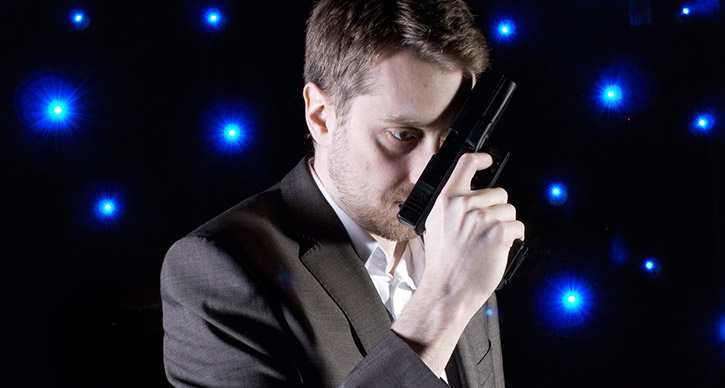
Photo: Rob Drummond in Bullet Catch. Bullet Catch is at the Arthur Miller Theatre in Ann Arbor on January 7-12, 2014. Photo courtesy of the artist.
Reviewing Bullet Catch for the New York Times a few months ago, Charles Isherwood noted that while the sound of gunfire onstage is hardly unusual, the shots in Bullet Catch “are more unsettling than most.” That’s because they’re real, because they’re fired by a volunteer from the audience, and because they’re aimed straight at the head of performer and creator Rob Drummond.
Drummond’s 75-minute show re-creates a stage trick that took off in Europe in the 17th century and remained popular well into the 19th—and on more than one occasion proved lethal. Drummond claims he’s exploring the idea of free will as an “illusion” by re-enacting the perilous stunt—and inviting an audience volunteer to join him—but Isherwood finds the whole thing “in terrible taste,” even though Drummond gives audiences a chance to leave just before the climactic “bullet catch.”
Performance trailer
I suspect Isherwood would have been none too happy with the 19th-century American stage, where actors repeatedly pulled out—and used—real firearms in yet another chapter in this country’s long and tumultuous love affair with guns. Before its renovation in the 1990s, my own favorite theater, the Fulton Opera House in Lancaster, Pennsylvania, built in 1852, was thought to bear the scar of at least one bullet on its proscenium arch—the result of a misfire by Buffalo Bill during one of his six appearances there between 1873 and 1882.

Buffalo Bill.
William F. Cody—aka Buffalo Bill—was perhaps the most famous practitioner of the so-called American “border drama,” but he had plenty of company. Go to a show in the late-19th century in one of the nearly 4,000 theaters that stretched across the nation, and you were likely to stumble on a play about Davy Crockett or Jesse James or Daniel Boone, about pioneers or rangers, miners or sharpshooters or Mormons with “one hundred wives.” The real American frontier may have been in its death throes, but the stage version was alive and well.
Audiences poured into theaters to see real “marksmen,” “sharpshooters,” “wing shots,” “rifle shots,” and “dead shots” shatter glass balls and tempt disaster. In his prairie dramas and Wild West shows, Buffalo Bill shot apples and potatoes from women’s heads and cigars from men’s mouths, often holding his rifle upside-down or firing backwards with the help of a mirror.
Cody seldom misfired, but others weren’t so lucky. On November 30, 1882, Frank Ivers Frayne killed his fiancee in front of a crowd of 2,300 inside Cincinnati’s Coliseum Theater.
Famed for the spectacular shooting stunts he wove into the plots of his plays (most of them set in the American West), Frayne was an expert marksman, capable of extinguishing a candle with a bullet, shooting a pipe out of a ranch hand’s mouth, firing a bullet through the rope of an innocent man about to be hanged, and shooting two guns simultaneously in two different directions, so that bullets shattered objects on either side of the stage—all tricks he performed during his 20-odd years of touring the country’s theaters. He taught his wife and two kids to shoot as well, and they often performed with him.
The backward shot
In his most daring stunt, “the backward shot,” Frayne blasted an apple off his wife’s head while propping his rifle on his shoulder and focusing in a mirror. (According to one account, the bullet sometimes not only pierced the apple but also triggered another rifle aimed at a plate suspended inches above Frayne’s head.) Ads reassured nervous theatergoers that the “backward shot” looked more dangerous than it was, because the actress wore a chain mail skullcap, and the apple rested on a six-inch hat.
After his wife’s death in 1880—apparently from natural causes—Frayne hired a 23-year-old actress named Annie Von Behren to be his assistant in the stunt, and the two became engaged.
At a matinee performance on Thanksgiving afternoon in Cincinnati on November 30, 1882, Frayne set up his backward shot as usual and pulled the trigger. A sudden burst of smoke enveloped his head, burning Frayne’s face and neck. The unexpected blast shoved the barrel of his rifle down by a few lethal inches, and with 2,300 people looking on, a bullet shattered Annie’s forehead. “My God! My God! What have I done?” Frayne bellowed as he rushed to her side. The curtain came down, and backstage, with Frayne moaning beside her, Annie Von Behren died. Frayne was charged with manslaughter but exonerated. He resumed performing in early 1883, some four weeks after the accident, but in a nod to safety he abandoned his most dangerous stunts. He continued to tour until his death in 1891.
Neither Frayne nor his promoters seemed to mind capitalizing on the tragedy. Announcements for his shows invariably mentioned Annie’s death, with graphic accounts of Frayne’s rushing to her and swooning over her corpse. The actor, papers reported, “is broken down with uncontrollable grief.” It was all theater—as is, I sometimes think, our contemporary fascination with guns and the tragedies they spawn.
And as I hope Bullet Catch will be. Asked if either the audience or he himself is in actual danger during the show, Rob Drummoned has said, “Them, no. Me, yes.” I have a sneaking suspicion I may be one of those audience members who heads for the exit when given the chance.
Interested to know Leslie’s post-performance response? Come back to UMS Lobby’s “People are Talking” section after the performance.
Propeller Blog: Behind the Scenes
Editor’s Note: Propeller performs Twelfth Night and The Taming of the Shrew in Ann Arbor, February 20-23. Leslie Stainton covered the company’s last visit to Ann Arbor in 2011 with Richard III. This post is a part of a series.
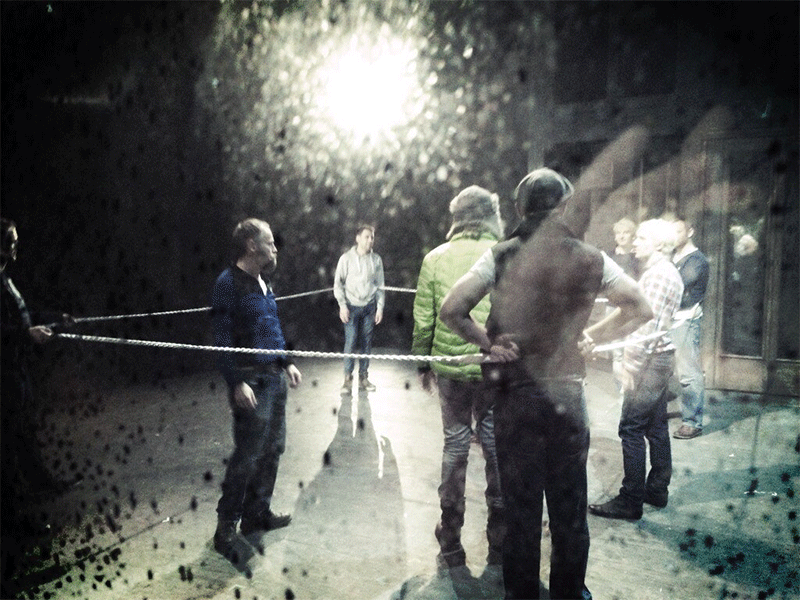
Photo: Actor Ben Allen took this photo inside the set.
From a Friday afternoon session with Nick Ferguson, production manager for Propeller, and U-M production and design students, these behind-the-scenes tidbits:
All of this had me marveling, again, at the audacity of touring. Propeller’s next U.S. venue is the Guthrie Theater in Minneapolis, where the big challenge will be maneuvering its towering wardrobes and chest of drawers up and down a thrust stage. Good thing they’re in Ferguson’s hands—he’s been working backstage in the theater since he was 17. Now “an old man,” by his account, he loves his work. “You never stop learning,” he says. “Especially in the theater.”
Propeller Blog: The Actor’s Freedom
Editor’s Note: Propeller performs Twelfth Night and The Taming of the Shrew in Ann Arbor, February 20-23. Leslie Stainton covered the company’s last visit to Ann Arbor in 2011 with Richard III. This post is a part of a series.
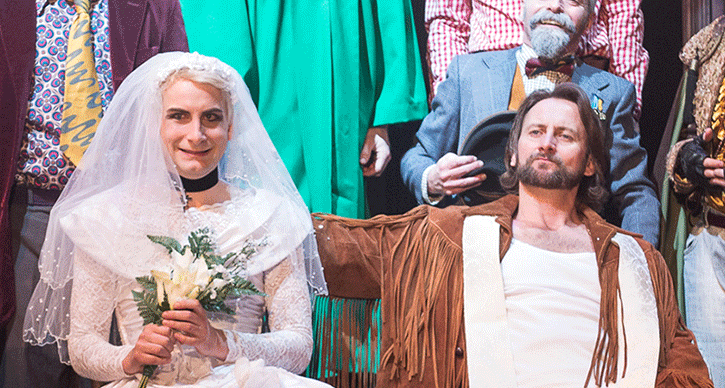
Photo: The Taming of The Shrew. Photo by Manuel Harlan.
I’ll confess up front I’d never seen Taming of the Shrew before. Never even read it. I had some gauzy idea—probably from Kiss Me Kate—that it was a happily-ever-after story about an ideally matched couple who couldn’t figure out they were meant for each other until they’d sparred around for two hours and wound up kissing.
I now know—or suspect—the reason I didn’t know the show is because it doesn’t get done all that much. And that’s because, like Merchant of Venice, it deals with things that make us very, very, very uncomfortable.
One of the first questions asked at the post-show Q&A last night: “Was it a comedy tonight?”
Answer, from a cast member: “The funniest thing about it is how stupid the men in the play are.”
In a book I return to regularly, The Actor’s Freedom, critic Michael Goldman argues that one reason we need theater is because of the actor’s freedom to handle “fearful materials…While on stage, the actor enjoys a kind of omnipotence, a privilege and protection not unlike that accorded sacred beings—whatever he is doing, whatever crimes he may appear to commit, he is not to be interfered with.”
You see Goldman’s idea played out to magnificent effect in this bracing, brutal show about domestic violence, staged as a play within a play—a merciful choice, as it turns out, because it releases us from what would otherwise be unbearable. (I dare anyone to smile at the show’s climactic image of Kate, as broken dog.)
Not that Propeller’s Shrew doesn’t have its moments of wild comedy or brilliant color or hip-thrusting ’70s tunes. But my guess is that’s not the part you’ll remember most. In the same week we marked the 50th anniversary of Betty Friedan’s Feminine Mystique, this production reminds us that Kate’s experience of spousal abuse is neither unique nor obsolete—as a number of cast members pointed out after last night’s show. Here’s Benjamin O’Mahoney (Grumio and Pedant) [start at 4:25 for related comment]:
Last night, as I watched actors play characters who were in turn playing characters, I realized again how vital this process is if we’re to confront and understand our basest selves. Identity is the “covert theme of drama,” Michael Goldman suggests. The fact that with Propeller, you’re seeing actors who played someone entirely different the night before only deepens the experience.
It’s a rare pleasure to see actors in rep like this, and to remember that this is how the theater once worked. Companies spent months on the road, traveling from town to town (we’ve got an old road house down the road from us in Adrian), switching roles nightly or sometimes twice in a day, layering roles upon roles. A huge nod of gratitude to Propeller for reviving the tradition and reminding us of the theater’s liberating powers.
Propeller Blog: Hauntings
Editor’s Note: Propeller performs Twelfth Night and The Taming of the Shrew in Ann Arbor, February 20-23. Leslie Stainton covered the company’s last visit to Ann Arbor in 2011 with Richard III. This post is a part of a series.
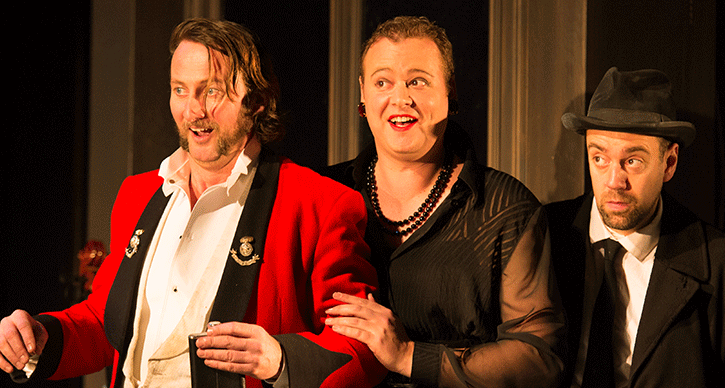
Photo: Twelfth Night. Photo by Manuel Harlan.
“Everything in the theatre, the bodies, the materials utilized, the language, the space itself, is now and has always been haunted, and that haunting has been an essential part of the theatre’s meaning to and reception by its audiences in all times and all places.” —Marvin Carlson, The Haunted Stage: The Theatre as Memory Machine
Among the ghosts I detected onstage Wednesday night—images and actions that reminded me of the last time I saw this company at work, here in Ann Arbor in 2011—were:
- Music—not recorded but performed onstage by the ensemble on an eclectic range of instruments, among them cello, clarinet, sax, bongo, wine glass and balloon
- Acoustic sound—no miked voices, thank god
- Chorus—the company is, for the most part, onstage throughout the show, donning half-masks to function collectively as both witnesses of and ghostly participants in the story
- Men playing women—I’d forgotten the unsettling pleasure of watching one gender impersonate the other (and, in the case of Viola-Cesario, male playing female playing male); this is how Shakespeare meant his plays to be seen, and while I don’t always love it, there is, as one actor said in last night’s post-show talkback, a “layering” that speaks to the ways we each layer ourselves in guises
- A quality of low-tech and handmade—of course this isn’t literally true (the show is designed and lit and costumed within an inch of its life), but you get the sensation this troupe of players has rather spontaneously come together on a platform to tell you a story, and they’re going to do it by hand, converting wardrobes into rooms, turning a chest of drawers on its side to function as a bar, picking up whatever musical instrument is at hand, grabbing costumes and props from a clothing rack, creating bird song with their own voices, acting out a tale as if they were kids in a playroom making their toys talk
- Syringe—remember Richard III with its sinister band of nurses? It came back in a flash last night when Sir Toby Belch produced a giant syringe to sedate Malvolio
There’s another way in which this production of Twelfth Night reminded me of Propeller’s last visit, and that’s the way it seemed to blend both previous productions—the somber, monochromatic Richard III and the zany Comedy of Errors—into a single show, at once monochromatic and zany. I’ve never seen a darker Twelfth Night, or a bleaker take on any Shakespeare comedy. Picture a score of actors, almost all of them in black, on a gray stage with sepia furnishings against a thundery sky. I kept waiting for unadulterated comedy to erupt from this gloomy space, and of course it did, but mostly in quick, jabbing bursts, and always with an edge.
And that’s as it should be, said actor Joseph Chance (Viola-Cesario) during last night’s post-show talkback. “There’s a lot of violence behind the play,” Chance told the hundred or so audience members who’d stayed behind to discuss the production with cast members. (I recommend it—and I’m not a big fan of talkbacks. There’s a second one tonight after Shrew.)
Malvolio’s humiliation is hilarious but also deeply cruel, Chance went on. It’s painful to behold. The ending of the comedy is not wholly sweet. Chance said he thinks this all “has a lot to do with Shakespeare’s ability to last through the years. He doesn’t pander.” The play is not unabashedly romantic, nor is it purely tragic—like life, it’s a mingling of both. When characters wonder if they’re going mad, they’re not being cute. There’s a real chance they are—and we literally hear that madness as it threatens to envelop them.
Here’s what assistant director George Ransley has to say about all this:
Caro McKay told me the other day that Shrew was the darker of the two plays on offer at Power. Now that I’ve seen Twelfth Night, I’m wondering how that’ll play out onstage. All I know is what actor Ben Allen said last night: “This show is monochrome. Shrew is disco lights like you’ve never had. It’s like drinking 10 espressos.”
Back in Town, and Loving It
Editor’s Note: Propeller performs Twelfth Night and The Taming of the Shrew in Ann Arbor, February 20-23. Leslie Stainton covered the company’s last visit to Ann Arbor in 2011 with Richard III. In this interview, Leslie chats with Propeller’s executive producer Caro McKay.
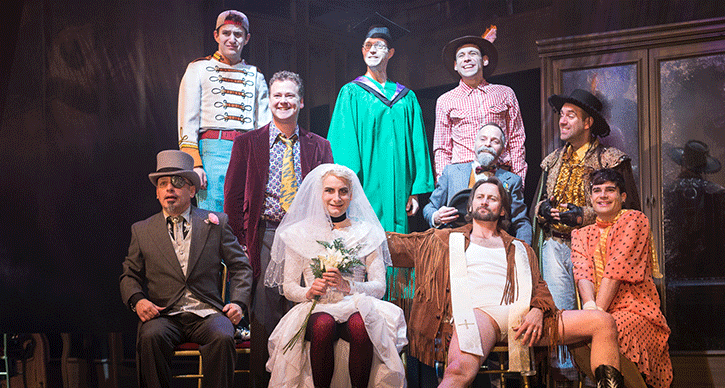
Photo: The Taming of The Shrew. Photo by Manual Harlan.
Caro McKay has been around the theater long enough to call herself “a dinosaur.” Now the executive producer of Propeller, she managed the English-language tour of the Peter Brook’s iconic Mahabarata back in the 1980s—a production students now learn about in performance studies classes, as McKay discovered to her surprise when she visited a class in U-M’s School of Music, Theatre, and Dance yesterday.
McKay’s been to Ann Arbor twice before—first with the venerable Royal Shakespeare Company nearly a decade ago, and then in 2011 with Propeller, the rambunctious, unpredictable, musically minded all-male troupe she launched a few years ago with the director Edward Hall. They’re all back in A2 this week with a pair of Shakespeare plays McKay says complement one another in dizzying ways—“because one is so harsh on love and marriage, and the other is so life-affirming about it.”
While crews were unpacking sets and focusing lights in the Power Center late yesterday afternoon, McKay took time to field a few questions by phone from her hotel room.
Leslie Stainton: What’s the best part about coming back to Ann Arbor?
Caro McKay: It’s the people. It really is. UMS is a fantastic host. And we’ve thoroughly enjoyed playing to the audiences. American audiences are very vocal. You let us know if you find it amusing or shocking. You tell us, and English audiences are rather restrained. It’s such a joy to have that interaction.
LS: What’s especially challenging about these two shows, Twelfth Night and Taming of the Shrew?
CM: Shrew is very funny but also very painful—there are very few kind words in that show. It’s the shorter, tighter, harsher of the two plays. For me it just passes in a moment, really. It’s riveting. And to follow up with Twelfth Night, which is a beautifully balanced bit of love with melancholy and humor—and also its own viciousness.
LS: Anything in particular we should be looking for in either play?
CM: Both shows are full of music. That’s very particular to Propeller, the way the actors are active musicians. I think there will be a lot for people to enjoy. I should just say very quietly that Act Two of Twelfth Night starts with a little bit of a tap dance routine.
LS: What about the sets?
CM: This time we’ve come back with a set that is shared between both productions, using wardrobes that you can walk into, out of, swing around. One wardrobe opens and has an organ. There’s an enormous great chandelier that is used in both plays. Twelfth Night can be quite black and white when we start in the beginning, in court, in this rather miserable little place … and then the color comes into it through the play.
LS: Are there certain moments where you’re especially curious to see how audiences react?
CM: I’m wondering how they will respond to the wedding in Shrew. So we’ll just wait and see what comments that might bring in. And to Petruchio and his servant. And I think the audience for Twelfth Night will enjoy the box tree scene—when Malvolio gets the letter to read. I think that is done in a rather different way. I’m very much looking forward to the comments. It was a rather lively debate last time.
What’s next in the Propeller pipeline?
CM: Our next two shows are Midsummer Night’s Dream and The Comedy of Errors. Popular titles. We’re building our audiences. Because a year after that, from the autumn of 2014 to 2015 we’re going to produce our history cycle. So we’re consolidating audiences, and then we’re going to sock ’em with a whole load of history. (Laughs.) Five plays, and we’ve decided that our version of the history cycle will include Edward III, which is attributed to Shakespeare.
LS: Any chance we’ll get to see it in Ann Arbor?
CM: We’d be so proud to. But I’m very very aware that Ann Arbor has had the RSC history plays! We would be only too proud—we love coming here already.
3 Questions for Director Wils Wilson
Editor’s note: This piece is a part of a series. You can also read Leslie Stainton’s essay on the power of place (or not) in theater.
Photo: Cast of The Strange Undoing of Prudencia Hart. Photo by Simon Murphy.
The Strange Undoing of Prudencia Hart is at Corner Brewery in Ypsilanti January 8-13. Our regular contributor Leslie Stainton interviewed the play’s director, National Theatre Scotland’s Wils Wilson.
Leslie Stainton: What happens to the theatrical experience when you move it into a pub (or other unconventional venue)? Does the audience change?
Wils Wilson: When the audience come into the venue for Prudencia Hart, there is a folk music session already going on. People are playing and singing, you can get a drink from the bar, you choose where to sit at small tables, and the performers come and talk to you in an informal way, asking you to do a simple task. So already the atmosphere is communal, convivial, playful and warm. We’re all in the same room together. It’s completely unlike the conventional theatre experience from the start, a different contract between audience and performers, one that allows space for a lot of intimacy, fun and emotional engagement.
A different space always brings with it a different audience. You get a conventional theatre audience, and you also get people who are intrigued to see how their bar or community hall will be used. There’s a sense of event, which has an appeal to a wide variety of people, so you often get a very mixed audience which is a huge advantage.
LS: How do Robert Burns, Border Ballads, and the poems of Robert Service speak to a global audience in the 21stcentury?
WW: David [David Grieg, creator of Prudencia] and I were attracted to the Border Ballads because they are fantastically dramatic stories of love, death, passion and the supernatural. They deal with such fundamental emotions and ideas they feel timeless. Robert Service’s wrote hugely popular tales of bold deeds in energetic rhyming verse again dealing with love, betrayal – big universal themes. It’s interesting, having played Prudencia now in a number of countries, that the idea of a folk tradition with stories of the devil and a borderland between this world and another, seems to be recognized wherever we go. The truth is that when you make a new piece, you just have to make something which feels necessary and relevant to you and which you yourself are truly interested in and challenged by – and if you make it well enough, it will speak to people wherever you go.
LS: Technology is increasingly defining our world. Where does live theater fit into this? How can theater help redress the imbalance we now seem in danger of experiencing?
WW: People will always be hungry for live theatre, music, dance, events. Nothing in the virtual world will ever replace seeing a real performer in front of you, seeing and feeling their emotion, seeing the sweat on their forehead.
So I think theatre should feel very confident just now, both in its own unique power and in how it engages with technological innovation. The two worlds don’t have to be seen in opposition. They will both continue to exist alongside each other, serving different needs.
The Power (or Not) of Place
Editor’s note: The National Theatre of Scotland performs A Christmas Carol on December 17 – January 3, 2016. The performance take place in an unconventional space: inside a box on the stage of the theater.
In my early twenties, I joined a children’s theater company and for half a year toured southeastern Pennsylvania putting on plays in elementary schools. I’d done my share of theater elsewhere, but nothing approached the energy of those performances. Every day we’d troupe off to another school to give our show and do a workshop. I’d been told children were the most demanding of audiences, but I never felt less than welcome anywhere we went, maybe because most kids were giddy with pleasure at the arrival of a bunch of costumed adults in their midst. (I played a dog.) It’s one thing to go to the theater, another to have it erupt in your cafeteria on a rainy weekday morning, much the way medieval pageants used to erupt in town squares.
We had little scenery and one change of clothes. I suspect we weren’t far from the kind of enterprise Peter Brook had in mind when he said the only thing needed for an act of theater to take place is for one person to walk across an empty space while someone else watches. The kids who sat cross-legged on carpet squares watching us perform certainly didn’t seem to distinguish between what we were doing and what took place downtown in the fancy 19th-century opera house our troupe called home—the kind of building Brook had in mind when he said of the theater: “Red curtains, spotlights, blank verse, laughter, darkness, these are all confusedly superimposed in a messy image covered by one all-purpose word.”
Photo (L to R): Palladio’s Olimpico, Radio City Music Hall, the Corner Brewery.
God knows the human thirst for stories has led to some amazing spaces: the ancient Greek amphitheaters with their literal sky, Palladio’s ornate Olimpico with its figurative one, Shakespeare’s Globe, the Sydney Opera House, Radio City Music Hall. But as pieces like Prudencia Hart remind us, it doesn’t much matter where plays are performed—or maybe it does matter, just not in ways we’ve been taught to expect. “Space that has been seized upon by the imagination,” writes Gaston Bachelard, “cannot remain indifferent space subject to the measures and estimates of the surveyor.” Performance transforms the sites we inhabit. I’ve often wondered if those elementary-school kids thought differently about their surroundings after we’d left. I hope so. Surely Ypsi’s Corner Brewery will be changed, perhaps in lasting ways, by what takes place inside it this January 8-13.
In a 2010 TED talk, Ben Cameron of the Doris Duke Foundation suggested that many purpose-built arts venues “were designed to ossify the ideal relationship between the artist and audience most appropriate to the 19th century.” Cameron and others argue that unless performing arts organizations rupture traditional thinking about arts settings, the whole culture of performance will stagnate.
It strikes me that what’s happening in the performing arts—where conventional performance venues are increasingly yielding to breweries, planetariums, armories, rivers (our own Huron!), and the local multiplex (witness the global appeal of the Met’s live broadcasts)—is not unlike what’s happening in the world of print publishing. Where either will end up is anyone’s guess, but we’re clearly changing the way we communicate—and with whom. When the Boston Lyric Opera presented two free outdoor performances of Carmen in 2002, more than 100,000 people showed up. A third of them were seeing an opera for the first time.
The National Theatre of Scotland proudly states on its website that it has “no building,” and therefore has “no bricks-and-mortar institutionalism to counter, nor the security of a permanent home in which to develop. All our money and energy can be spent on creating the work”—which they perform in places as varied as car parks, forests, Edinburgh’s Royal Lyceum, and Ypsi’s Corner Brewery.
Back when I toured with the kids’ theater troupe, we had no box office, no lobby, no lights, no stagehands, no drops descending from on high, no tickets or sound system or props— just ourselves and what we could carry in the back of a station wagon. Our audiences didn’t care. Maybe some of it had to do with their age. But I’m sure it also had to do with the enduring power of make-believe, the freedom that actors represent, and the startling discoveries that can happen when a familiar space is made new, and the audience with it.
Renegade Reflections – Guest Blog by Leslie Stainton
Editor’s Note: Lobby contributor Leslie Stainton will guest blog the San Francisco Symphony American Mavericks festival throughout this weekend. Read her notes on Friday, Saturday, and Sunday.
What’s next for Jeremy Denk? Definitely not Disneyland. After Sunday’s rollicking performance of Lukas Foss’s “Echoi”—a pseudo-string quartet that lent new meaning to the word “string”—the pianist was heading to Carnegie Hall, where the SF Symphony will reconfigure its Mavericks series for New York audiences this week. Denk said he and his fellow performers are bracing for a different kind of reception from the one they got here. I asked him after Sunday’s performance how he’d liked his week in A2:
Sunday’s concert drove home for me some of what the Mavericks series—and the Renegade series overall—have achieved:
- An expanded idea of what constitutes a musical instrument (Foss’s “Echoi” culminated in a dramatic thrashing of a dusty garbage-can lid) and the sounds that musical instruments—including the human voice—are capable of making. Piccolo as siren, bass fiddle as drumhead, soprano as piccolo. Our isle is indeed full of strange noises.
- A humbling appreciation of how conventional our musical tastes tend to be. Bach on the radio this weekend just didn’t do it for me. I’m sure I’ll swing back, but after the likes of David del Tredici, the Baroque seems a tad tame just now.
- Magnificent resonances—not just within the Mavericks series but within Renegade as a whole. Echoes of “Einstein on the Beach” throughout, most recently in yesterday’s vocal works by Meredith Monk and Morton Subotnick. Hints of the Hagen Quartet’s furious playing in yesterday’s Foss quartet, traces of the Tallis Scholars in Monk’s unorthodox blending of voices, and so on …
- The urgency of live performance—especially now, when we filter so much of our human experience through screens.
- The urgency of a vibrant cultural life—and the need to support it. (Thank you again, Maxine and Stuart Frankel.) Yesterday’s paper brought news of dwindling arts support in Europe. Artists and arts organizations are being asked to justify their existence by demonstrating economic impact. It’s a killer for small, weird stuff like the kind of music we’ve just spent four days absorbing, or something as mind-opening as Robert Lepage’s “Andersen Project.” And yet how vital the enterprise is to being human. I was reminded of it at last week’s American Orchestra Summit here in A2, when two bright and gifted teenagers talked about what music—hearing it, playing it, studying it—meant to their existence. This stuff saves lives, don’t kid yourself.
- The many ways that unconventional work stretches performers and audiences alike. A friend remarked to me yesterday that he’d never much liked contemporary music before, but the Mavericks series had changed him. I feel the same way. This has been a mind-expanding experience—a giant “Maverick martini,” without the hangover.
I asked a few people who’ve been closely involved with the Renegade series since its inception to reflect on the past two months—high points, low points, and everything in between:
“Stretch. That’s the word that’s come to my mind most often over the past 10 weeks, and especially in the past four days with the SFS. I love this feeling that, even when I think I’ve seen it all, something like the Renegade series stretches me in new and exciting ways as an audience member. I’ve felt myself grow, becoming more willing to tackle the ambiguous or unfamiliar, and to give myself over to these experiences in the moment. The big gift of Renegade for me is that it seems to have opened up a much more public conversation about what UMS is putting on the stage, and audiences are describing their experiences in more nuanced and complex ways (we’ve made good progress away from the like/dislike dichotomy!). With Renegade, we set upon a journey of intentional watching/listening/experiencing. It’s been interesting to see how some of us really embrace that idea, and it begins to change in new and exciting ways how we experience performance. And now that the journey has come to an end, I’m aware of how exhausting it can be to be stretched, but I’m looking forward to using this greater capacity that I’ve developed within myself and applying it to next season.”—Jim Leija, Education Director, UMS
“I was constantly on my toes. I was surprised and never knew what to expect. Just as I would sit back and say, ‘Well, yes, yes. this is going to be something I’m familiar with,’ WHAAM, something would happen to engage me/entrance me/surprise me. I am exhausted by LISTENING to all that fabulous music.”—Prue Rosenthal, Former Chair, UMS Board of Directors
“I will admit that I approached the series with some trepidation, not being sure if audiences would be receptive to the works programmed on the series. It was such a thrill on Thursday night to see the instantaneous positive response – a response that mostly continued throughout the four concerts. Not everybody liked everything, nor would I expect them to, and in all honesty, I wish more of the dissenters had posted on the Lobby also. But there was something really powerful about hearing so much modern music in a concentrated timeframe and realizing that it isn’t as scary as it looks on paper. I wish we could clone MTT, who is able to bring meaning to the pieces with just a few words about each composer. One commenter on the Lobby website was dismayed by this music being ‘ghettoized’ (my word, not the commenter’s) in one program, and thought it would be better to have it interspersed with other, more traditional works. But I’m not convinced of that. Henry Cowell in the context of Tchaikovsky or Brahms will have a decidedly different impact than when heard in the context of Varese, Ruggles, or Harrison. These concerts were a great way to introduce the idea that modern music IS accessible and enjoyable, not that it’s medicine that you need to take in order to get the Beethoven. On the whole, I was so proud of our community for embracing this festival wholeheartedly. It’s fine not to like everything – heck, I run fleeing whenever Brahms is on the program! – but the willingness to embrace the unknown was just another example of why I live in Ann Arbor.”—Sara Billmann, Director of Marketing & Communications, UMS
“What made me happiest about Mavericks and Renegades was not always knowing in advance what was going to ‘work.’ Concert programming so often presents us with an unbroken string of success stories, and that was definitely not the case with the American Mavericks’ works, several of which were ‘hot off the press.’ I was thrilled by Varèse, Cowell, Bates (of whom I’d never heard), and Foss . . . and bored by Monk and Subotnick (I don’t handle rhythmic monotony well). What was exciting in most cases, though, was not knowing what to expect. This has been an ear-freshening semester, and UMS has my sincere thanks for that.”—Steven M. Whiting, Professor, UM School of Music, Theatre and Dance; Guest Lecturer, UMS Night School
“I’ll never forget the bookends of the series — Einstein and the San Francisco American Mavericks concerts. Both were transformative to my perspective on culture in American life—watching Einstein be remounted and come into being on campus was phenomenal and gave me a rich appreciation of the work; the symphonic realization of Ives’s Concord Piano Sonata clarified my vision of the work and is still ringing in my ears. Over the course of the Renegades Series, I’ve come to see the figure of the Maverick in American culture as less of an outlaw and more of a driver of innovation, really a thought leader. That Mavericks have become a tradition in America and across the globe gives me hope that we can solve the problems that we face as a nation and world citizens. I’m certain that the Renegade Series has inspired the whole campus, faculty and students alike. Another takeaway has been the incredible value of attending shows that I don’t usually attend — for me dance and theater. UMS provides us with a rich variety of cultural experiences, and I think we as audience members need to challenge ourselves more often to attend things outside of our experience. Certainly the students in my Mavericks and Renegades class have discovered the value of expanding their cultural diet, we’ve all grown as a result.”—Mark Clague, Associate Professor of Music; Instructor, UMS Night School
The Lives of Men – Guest Blog by Leslie Stainton
Photos from the UMS Archive. 1. L-R: Gordon Mumma with visiting composer Morton Feldman, ONCE Festival (1964), Ann Arbor. (Photo: Donald Scavarda) 2. Morton Feldman in Ann Arbor, ONCE Festival (1964). (Photo: Makepeace Tsao, courtesy of the Tsao Family)
Editor’s Note: Lobby contributor Leslie Stainton will guest blog the San Francisco Symphony American Mavericks festival throughout this weekend. Read her notes on Friday and Saturday.
Biography kept popping up. From Saturday’s pre-concert presentation on Charles Ives and his Concord Sonata, to the intros to each of the evening’s pieces, to the final, riveting and mercurial Concord Symphony, character and personality held center-stage throughout last night’s program. I’ve devoted huge parts of my life to writing and reading biography, so I generally don’t need convincing, but I found myself wondering at times last night whether it makes a difference to know, for example, that Carl Ruggles hated Brahms and destroyed much of his own work, or that Morton Feldman was a friend of Mark Rothko. In the end, I think it does.
Before each of the three pieces on Saturday’s program, Michael Tilson Thomas spoke briefly, and fondly, about its composer. Of the difficult and “craggy” Carl Ruggles, whose “Sun-treader” (1931) opened the evening, MTT said, “He spent most of his life pent-up in a small, one-room schoolhouse in Vermont with a piano a pot-bellied stove, and his adoring wife.” On weekends, Ruggles was visited by the likes of Thomas Hart Benton (who used the composer as a model for Ahab in his illustrated “Moby Dick”). Ruggles produced a slender oeuvre—just a dozen or so works—and they’re filled with defiance, rage, deep sorrow, and an aching passion, MTT said. “You instantly know it’s a statement by Carl Ruggles. So get ready.”
And he was right. With its huge and sober sounds, beautiful and raging all at once, “Sun-treader” seemed to me a palpable cry. I kept thinking of Icarus, striding toward the sun in his doomed chariot. And of Ruggles himself—a man who denounced the mainstream, an outlier unafraid of gods.
If Ruggles was a small man who wrote big, MTT said by way of introduction to the second work on the program, Morton Feldman was a big man who wrote delicate music. And then MTT launched into a brief imitation of Feldman—put on your best Brooklyn accent, and you’ve got it. “Dis work is de classiest ting Ay eva wrote,” Feldman (in MTT’s version) might have said about his “Piano and Orchestra” (1931), which MTT described as a cross between Webern and Duke Ellington. Elegant it was, as subtle and moving as a Rothko canvas (to which both MTT and the program notes likened Feldman’s work—MTT noting that “time” was Feldman’s “canvas”).
At one point during this languid piece, I felt as if I were hearing a deeply sophisticated “Peter and the Wolf,” so magically did the work illuminate each instrument in the orchestra, allowing us to focus on color and tone rather than the usual culprits, melody and rhythm. (Is it stretching things to suggest this functioned at least in part as a “biography” of an orchestra?)
Biography returned full-force in Charles Ives’s “Concord Symphony,” the last work on Saturday’s program, with its four sections devoted to four men who inhabited the legendary town where the American Revolution erupted—Emerson, Hawthorne, Alcott, Thoreau. MTT described the symphony as an epic, and it was. Big, bracing, with sudden and exquisite moments of tenderness nestled among passages of utter fury. I’ve always liked Ives, the Connecticut iconoclast who made his living selling insurance and persisted in writing works that few wanted to hear. But this piece brought him to life in ways I hadn’t heard before—and underscored the majesty and “Americanness” of his often nostalgic vision. A woman I spoke to after the performance summed it up: “This felt almost classical,” she said—especially after Friday night’s foray into the world of John Cage.
I do have one question about biography—where are the women in this series?
During intermission, I cornered the American composer and U-M faculty member Michael Daugherty, who was sitting a few rows in front of me, and asked him what these concerts meant to him:
Word has it that Carnegie Hall is having a tougher time filling its house for these concerts next week than Hill (a larger hall in a far smaller community). It’s a credit to Ann Arbor audiences, as Daugherty reminded me:
Cat Calls, Cheers, and the Glories of Sound – Guest Blog by Leslie Stainton
Photo: From left to right: Jessye Norman, Michael Tilson Thomas and Meredith Monk perform in John Cage’s Song Books during the San Francisco Symphony’s American Mavericks Festival at Davies Symphony Hall in SF on March 10. Photo credit: Kristen Loken.
Editor’s Note: Lobby contributor Leslie Stainton will guest blog the San Francisco Symphony American Mavericks festival throughout this weekend. Her first post is here.
The ride—we’ve definitely moved from journey to ride—continued on Friday night with a rollicking three-hour Mavericks program that included a witty tribute to Beethoven, a tempestuous plunge into the pleasures of sirens and things that go thwack, a surprisingly lyrical piece by the same Henry Cowell who’d shattered any peace on Thursday night, and the evening’s most talked-about event—a gloriously funny, straight-from-the-Sixties, half-hour spectacle by John Cage, featuring Jessye Norman, Meredith Monk, Joan La Barbara, and Michael Tilson Thomas. The latter showed off his prowess at the blender by whipping up a smoothie. (Recipe not included.)
Here’s what Bob Wallin, who sat behind me (and is no musical slouch, being a season ticketholder at UMS, Lyric Opera, and Michigan Opera Theater), had to say about it:
Wallin wasn’t alone. When the lights fell on the last of Cage’s mania, someone in the audience began booing. It’s the first time anyone I spoke to can remember a boo in Hill Auditorium. Was he a plant? UMS’s marketing director Sara Billmann swears not, as does San Francisco Symphony’s Susan Key. So here’s my challenge: will the real booer please come forward?
Out in the lobby during intermission, I encountered Garrett Schumann, a composition student at U-M, who thought it was all great fun. He especially liked it that audience members literally stood up to the booer with cheers, thunderous applause, and a standing ovation. Here’s Schumann’s take:
I later ran into a former music buyer for Borders who felt much the same. “I mean, you come to a John Cage concert, what do you expect? It’s not as if this is 1913.”
Whatever else you thought of the Cage piece—which had to have cost a small fortune, by the way, given all the personnel and technology assembled onstage—it was a hoot to be there. A Happening in 2012 in staid Hill Auditorium? Worth every excruciating minute.
The second half of the program—Henry Cowell’s riveting “Synchrony,” with its gorgeous trumpet solo; John Adams’s aptly named “Absolute Jest,” whose opening strains made hay with Beethoven’s 9th; and Edgard Varèse’s pounding “Amériques,” with no fewer than 12 percussionists and a massive brass section—had me wanting to shout with glee as I left Hill. All through the evening, I kept thinking about sound: what we hear when we’re not really listening, how beautiful something as chilling as a siren can be, how innately musical noise is, how many magnificent and bizarre and thrilling and offputting ways humans have managed to create sound. A bass drum suspended 12 feet in the air, a bassoon played with a violin bow, a heckelphone—who knew?
By the end of the evening, even my seatmate Bob Wallin had forgotten Cage:
First “Mavericks” – Guest Blog by Leslie Stainton
Photo: The SFS percussion performing in Lou Harrison’s Concerto for Organ and Percussion Orchestra as part of the Opening Concert of the American Mavericks Festival in San Francisco. (l-r James Lee Wyatt, Artie Storch, Tom Hemphill) Credit: Kristen Loken.
Editor’s Note: Lobby contributor Leslie Stainton will guest blog the San Francisco Symphony American Mavericks festival throughout this weekend.
For starters, there was the matter of dress: instead of 19th-century penguin suits, the men in the SF Symphony’s opening American Mavericks concert last night wore casual black pants and open-collared black shirts. You could feel their pleasure. That pleasure turned into radiant joy as the evening progressed, and the musicians worked their way through the bracing, at times tempestuous, at times haunting music of Copland, Cowell, Lou Harrison, and the young, Philadelphia-born Mason Bates, who performed onstage in his own evocative “Mass Transmission,” which had its world premiere last week in San Francisco.
Even if you think you hate this stuff—and for those who chafe at dissonance, there was plenty to hate—last night’s concert was a marvel. If only for the chance to see oxygen tanks take a percussive pounding center-stage. If only for the chance to hear Hill’s glorious organ get a workout the likes of which might have made Bach’s jaw drop. If only for the sheer delight of watching pianist Jeremy Denk slam his body into a Steinway again and again and come up beaming.
If only for the brief and almost gossipy talks Michael Tilson Thomas gave before each work on the program. Thomas not only knows these pieces but knew the composers and told stories about each, so as you listened to the works you could picture old Henry Cowell hanging out with an Irish cult in the woods north of San Francisco or Lou Harrison proudly driving one of the Bay Area’s first cars to run on leftover restaurant grease.
A few highlights:
7:17 pm
As the orchestra tunes up onstage—no happy trills here, but rather discordant tones, squeaks, mournful bleats—I read with admiration a short program note by co-sponsor Maxine Frankel, who says she and her husband helped fund these concerts to ensure that UMS “has the flexibility to consider the new, the different, the innovative, and the cutting-edge.” In a country whose public schools are slashing arts education, we desperately need this kind of thinking. Thank you, Frankels.
7:35 pm
Michael Tilson Thomas takes the stage. “What does it mean to be a maverick?” he asks. The next four nights will help shape answers.
7:48 pm
Midway through Copland’s “Orchestral Variations,” percussionists are snapping their fingers. My husband and I look at each other and grin. “This is so refreshing,” he says to me later. “The array of different sounds.”
7:55 pm
Introducing Henry Cowell’s “Piano Concerto,” MTT (as orchestra members call him) speaks of the composer as a Bay Area “maverist” famous for “vast splodges of notes.” Thomas says we can expect to hear traces of Cowell’s prodigious knowledge as an ethnomusicologist—and we do.
7:58 pm
The opening notes of Cowell’s concerto sound like cars in traffic. But then: surprising beauty. I feel for a moment as if I’m at a cocktail party with someone rippling the piano in the background. Jeremy Denk’s face is a wonder: he grimaces, shakes his jowels, heaves his body into the keyboard.
8:06 pm
The piano as machine gun.
8:10 pm
Denk convulses. He’s playing impossibly fast. Chopsticks on speed.
8:14 pm
Utter cacophony suddenly and bewilderingly culminates in an almost kitschy Hollywood ending. We’re done. The audience erupts. My friend Jim Kister, who’s sitting two rows in front of us, and whose musical tastes run to the conventional, takes his time applauding. During intermission I ask him what he thought:
8:28 pm
I ask one of the ushers how she liked the first half. “It’s unique,” she says, tight-lipped. And then: “I’m anxious to see what they do with the oxygen tanks.” She means the string of big tanks parked downstage left, which have yet to be used. There are also big wooden drums, suspended gongs, chimes, a celesta.
8:40 pm
The U-M Chamber Choir takes the stage for Mason Bates’s “Mass Transmission.” Shouts of recognition from friends in the crowd. Bates himself looks like a college kid—skinny, dressed in a pullover and jeans, I think. He’ll function like a DJ on what he calls “electronica”—digital samplings and techno beats.
8:57 pm
This piece is gorgeous. Consonant, accessible. “Maverick” doesn’t have to be ugly, I realize. I didn’t expect to be moved to tears tonight, but Bates achieves it with his lyrical rumination on communication, technology, and the love between a mother and her daughter. Earlier he’s described this piece, about one of the world’s first long-distance communications initiatives, as “basically a story of skyping in 1920.”
9:04 pm
An ethereal ending—tones just drift off, and we’re left to contemplate the (presumably now-dead) real-life mother and child at the heart of this piece, and the way we live today vs. the miracle of this kind of communication nearly a century ago. How clever of Bates to use new technology to simulate and suggest the old. And through it all, the power of the human voice (which Bates says represents “the most beautiful animal warmth we have.”)
9:11 pm
MTT introduces the last piece, Lou Harrison’s “Concerto for Organ with Percussion Orchestra.” The stage is stripped away—just the organ and an array of often bizarre instruments (rasps, rattles, plumber’s pipes …). I’m reminded of the friend who refers to the percussion section as “the toy department.” MTT says, “This concerto represents Harrison’s extraordinary view of the musical world.” It’s got the rhythmic drive of the gamelan, of Africa, hints of 12-tone music, Middle Eastern vocal traditions.
9:20 pm
I’m hearing echoes of “Einstein on the Beach” in the organ’s runs. UMS has truly bookended its Renegade series.
9:25 pm
Medieval sounds. Beauty I didn’t expect.
9:31 pm
More echoes of “Einstein.” Was Glass a disciple of Harrison?
9:40 pm
A rousing evenings ends in a burst of percussive battering that folds into the eloquent ring of a suspended gong. Long fade to silence, and then again, the audience is on its feet. Earlier another friend I’d spotted in the audience told me, “I had a cup of coffee beforehand, because I thought I might have trouble staying awake, but it’s the last thing I needed.
Afterward, I run into Mona DeQuis and a colleague from the DSO shop, who are selling CDs in the lobby. We talk about the evening’s music:
Space is Flexible. Time Warps.
Lots of talk at Saturday Morning Physics on who Einstein is/was and what he represents.
Composer Philip Glass: “As I worked on Einstein on the Beach, I began to see Einstein as a poet.” (Interestingly, Glass sees himself as “kind of a failed scientist.” He admits he wanted to be three things as a kid: musician, scientist, dancer. Of the three, he became just one.) Glass also notes that Einstein was the first scientist to become a celebrity.
Physicist Sean Carroll, of the California Institute of Technology: Einstein’s theories changed the definition of time. They taught us that “everybody’s watch reads personally.”
Theoretical physicist Michael S. Turner, of the University of Chicago: “Einstein changed the way we think about something that was very basic—space and time.” Turner teaches a course on Einstein and relativity. The gist of the course, Turner says, can be summed up in two sentences: “Space is flexible.” “Time warps.”
On those last two sentences, here’s UM’s Martin Walsh, a theater professor at the Residential College, on the time-warping experience of watching Einstein on the Beach at the Power Center on Friday night:



